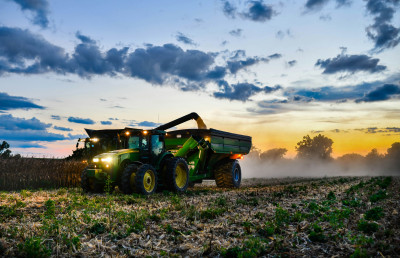The agricultural machinery sector stands at the threshold of a dual transformation—economic and technologically. Following the boom years of 2021/22, Western markets for tractors and harvesters have cooled. Simultaneously, electrification, autonomy and digital fluid power are driving an innovation wave that will redefine the agricultural machinery landscape by 2040. Fluid power remains the backbone of these machines, from energy-efficient hydraulics and electro-hydraulic CVT systems to intelligent actuators for autonomous vehicles.
1. Global Markets in Transition (2025-2030)
The years 2024 and 2025 mark a consolidation phase. North America and Europe are recording double-digit declines, whilst Asia ascends as the dominant production region:
North America: A decline of approximately 12% is expected for 2025. Rising interest rates and low commodity prices are dampening investment, particularly in large tractors above 100 hp.
Europe: The market is contracting by roughly 8%, burdened by high inventory levels and capital expenditure restraint. A cautious stabilisation has been observed in towards H2 2025, driven by Green Deal programmes and precision technology.
China: The government is using "Green & Smart" subsidies to specifically promote high-tech machinery: CVT tractors, intelligent sprayers and autonomous units. OEMs such as Weichai Lovol and Zoomlion are constructing new facilities with capacities exceeding 100,000 tractors annually.
India: With over 900,000 tractors per year, the country is now the world's largest market. However, mechanisation rates remain at approximately 45%, indicating substantial potential for the coming years.
By 2030, roughly 80% of all agricultural machinery will be manufactured in Asia, whilst the value share there will reach around 55%. This opens new opportunities for European and American suppliers in the premium segment—particularly in hydraulics, sensors and control technology.
2. Technology Shift: Four Drivers of Change
Four themes define OEM development strategies: electrification, autonomy, precision and connectivity.
John Deere, CNH Industrial, AGCO, Kubota and others are investing heavily in electric drives, AI-supported image processing and cloud platforms. Yet fluid power technology remains indispensable, as it forms the bridge between digital control and physical power transmission.
Examples
Electro-hydraulic CVT systems couple variable drives with sensitive load control.
Intelligent pumps and valves respond to sensor values in real time, increasing energy efficiency and reducing leakage losses.
Digital fluid power integrates pressure, temperature and condition data into machine control—the foundation for predictive maintenance and new service concepts.
The Fendt e100 Vario illustrates the current state: 100 kWh battery, 55 kW electric motor, yet 113 l/min hydraulic output at up to 450 bar. vHydraulics retain a central role even in electric tractors. At the current technology level, batteries remain practical only in smaller power classes due to weight constraints.
3. Development Trajectories to 2040
By 2030
Electric tractors will reach approximately 5% market share, primarily in the sub-75 hp segment.
Autonomous tractors and sprayers become reality; "driver optional" is standard for large machines.
Precision agriculture utilises AI, cameras and machine vision—spot spraying reduces herbicide consumption by up to 80%.
Hydraulic systems become "smart": sensors, connectivity and condition monitoring increase availability and efficiency.
By 2040
Electrified and hybrid machines account for 20–50% of new registrations, depending on region.
Small units, field robots and drones operate almost entirely electrically.
Large machines combine combustion engines, fuel cells and high-pressure hydraulics in intelligent hybrid architectures.
Fluid power becomes software-defined: electro-hydraulic actuators, adaptive valve controls, intelligent pressure and energy management systems.
4. Implications for Fluid Power Technology
For the hydraulics and fluid power sector, this transformation does not signify declining relevance but rather a new field of innovation.
Digitalisation: Sensor integration, condition diagnostics and data management become standard. Hydraulics enters the IoT era.
Hybridisation: Electric and hydraulic systems converge; control increasingly becomes mechatronic.
Efficiency: Variable pumps, load-sensing and pressure-optimised systems reduce energy consumption and heat losses.
Regionalisation: Local manufacturing and adaptation to new markets—particularly China, India and Southeast Asia—gain importance.
Fluid power technology remains a key technology because it delivers what electric systems alone cannot (yet): high forces transmitted precisely, efficiently and robustly.
5. Outlook: Fluid Power at a Strategic Crossroads
The coming 15 years will determine whether Europe's supply industry can maintain its position as innovation leader.
Those investing today in intelligent hydraulic systems, software integration and local manufacturing will remain relevant in an agricultural sector that is simultaneously becoming more productive, sustainable and data-driven.
Beyond 2033, hydraulics will share the stage: oil will only be deployed where it offers clear advantages—combined with electric drives for light to medium loads. Software consequently gains further importance—for instance in overarching energy management, optimising the control of electric drives and hydraulic implements. Fluid power component suppliers should establish intellectual property partnerships with specialists in autonomy and battery technology in good time, to retain a central role in the next generation of field robots.


